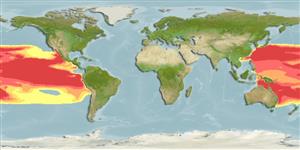Common names from other countries
>
Scombriformes (Mackerels) >
Bramidae (Pomfrets)
Etymology: Brama: Old French, breme, bresme = a fresh water fish; 1460 (Ref. 45335).
Environment: milieu / climate zone / depth range / distribution range
Ecologia
marino; distribuzione batimetrica 1 - 200 m (Ref. 58302). Temperate
Western Pacific (Ref. 559). Reported from the Hawaiian Islands (Ref. 58302).
Size / Peso / Age
Maturity: Lm ? range ? - ? cm
Spine dorsali (totale) : 0; Raggi dorsali molli (totale) : 33; Spine anali: 0; Raggi anali molli: 27; Vertebre: 40. This description is base on a 4.9 cm SL specimen caught near Ogasawara Islands, Japan. Body strongly compressed. Pectoral fin situated relatively high on body. Posterior margin of preoperculum serrated.
Known only from young and juvenile specimens.
Life cycle and mating behavior
Maturities | Riproduzione | Spawnings | Egg(s) | Fecundities | Larve
Masuda, H., K. Amaoka, C. Araga, T. Uyeno and T. Yoshino, 1984. The fishes of the Japanese Archipelago. Vol. 1. Tokai University Press, Tokyo, Japan. 437 p. (text). (Ref. 559)
IUCN Red List Status (Ref. 130435)
CITES (Ref. 128078)
Not Evaluated
Threat to humans
Harmless
Human uses
Strumenti
Special reports
Download XML
Fonti Internet
Estimates based on models
Preferred temperature (Ref.
115969): 19.6 - 28.2, mean 26.1 (based on 126 cells).
Phylogenetic diversity index (Ref.
82804): PD
50 = 0.5039 [Uniqueness, from 0.5 = low to 2.0 = high].
Bayesian length-weight: a=0.01820 (0.00782 - 0.04232), b=2.96 (2.76 - 3.16), in cm Total Length, based on LWR estimates for this (Sub)family-body shape (Ref.
93245).
Trophic level (Ref.
69278): 4.0 ±0.6 se; based on size and trophs of closest relatives
Resilienza (Ref.
120179): Medio, tempo minimo di raddoppiamento della popolazione 1.4 - 4.4 anni (Preliminary K or Fecundity.).
Fishing Vulnerability (Ref.
59153): Moderate vulnerability (36 of 100).
